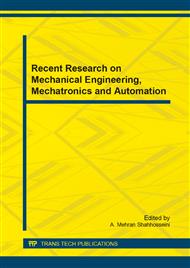[1]
International Civil Aviation Organization, Advanced surface movement guidance and control systems (A-SMGCS) Manual, (2004).
Google Scholar
[2]
J A Besada, A Soto, G Miguel, Design of an A-SMGCS prototype at Barajas airport: Airport surveillance sensors bias estimation, Proceedings of the 7th International Conference on Information Fusion. Philadelphia: IEEE Press, 2005, pp.1343-1350.
DOI: 10.1109/icif.2005.1592012
Google Scholar
[3]
J Garcia, J M Molina, G Miguel, Design of an A-SMGCS prototype at Barajas airport: Data fusion algorithms, Proceedings of the 7th International Conference on Information Fusion. Philadelphia: IEEE Press, 2005, pp.1335-1342.
DOI: 10.1109/icif.2005.1592011
Google Scholar
[4]
J Garcia, A Berlanga, M Molina, Methods for operations planning in airport decision support systems, Applied Intelligence, 2005, pp.183-206.
DOI: 10.1007/s10791-005-6618-z
Google Scholar
[5]
A G Marin, Airport management: taxi planning, Annals of Operations Research, 2006, pp.191-202.
Google Scholar
[6]
P C Roling, H G Visser, Optimal airport surface traffic planning using mixed-integer linear programming, International Journal of Aerospace Engineering, 2008, pp.1-11.
DOI: 10.1155/2008/732828
Google Scholar
[7]
V H L Cheng, V Sharma, D C Foyle, A study of aircraft taxi performance for enhancing airport surface traffic control, IEEE Transactions on Intelligent Transportation Systems, 2001, pp.39-54.
DOI: 10.1109/6979.928715
Google Scholar
[8]
W M Hollister, Airport surface traffic automation study, DOT/FAA/PS-87/1, Washington D.C.: Federal Aviation Administration, (1988).
Google Scholar
[9]
M Watnick , J. Ianniello, W Joseph, Airport Movement Area Safety System, Proceedings of 11th IEEE/AIAA Digital Avionics Systems Conference. Seattle: IEEE Press, 1992, pp.549-552.
DOI: 10.1109/dasc.1992.282103
Google Scholar
[10]
Ianniello, W Joseph, M Kruczek Raymond, Airport surface collision warning system implementation, Proceedings of the IEEE-IEE Vehicle Navigation & Information Systems Conference, VNIS 1993. Ottawa: IEEE Press, 1993, pp.742-746.
DOI: 10.1109/vnis.1993.585730
Google Scholar
[11]
E S Katz, Evaluation of a prototype advanced taxiway guidance system (ATGS), DOT/FAA/AR-TN00/9, Washington D.C.: Federal Aviation Administration, (2000).
Google Scholar
[12]
TANG Xinmin, Zhu Xinping, Han Songchen, Petri net controller synthesis for advanced surface movement guidance and control system, Proceedings. of 2009 IEEE International conference on Information and Automation. Guangzhou: IEEE Press, 2009, pp.483-488.
DOI: 10.1109/icinfa.2009.5204972
Google Scholar
[13]
J Garcia, J Besada, Miguel G, Data processing techniques for conflict detection on airport surface, Fifth Eurcontrol-FAA ATM R&D Seminar. Budepest: 2003, pp.1-10.
Google Scholar
[14]
J Teutsch, V Mollwitz, Virtual block control and separation bubbles in ATC low visibility operations, Integrated Communications, Navigation and Surveillance Conference. Arlington: IEEE Press, 2009, pp.1-17.
DOI: 10.1109/icnsurv.2009.5172840
Google Scholar


